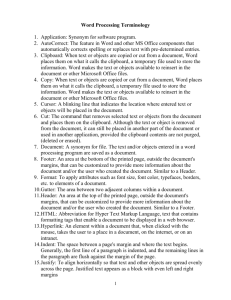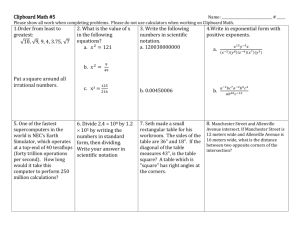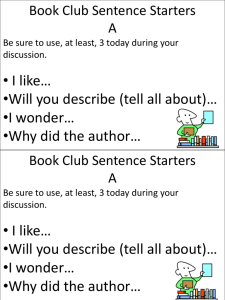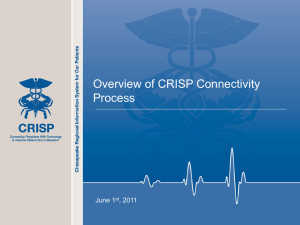Welcome to “12 Strategies!” SELF STARTER:
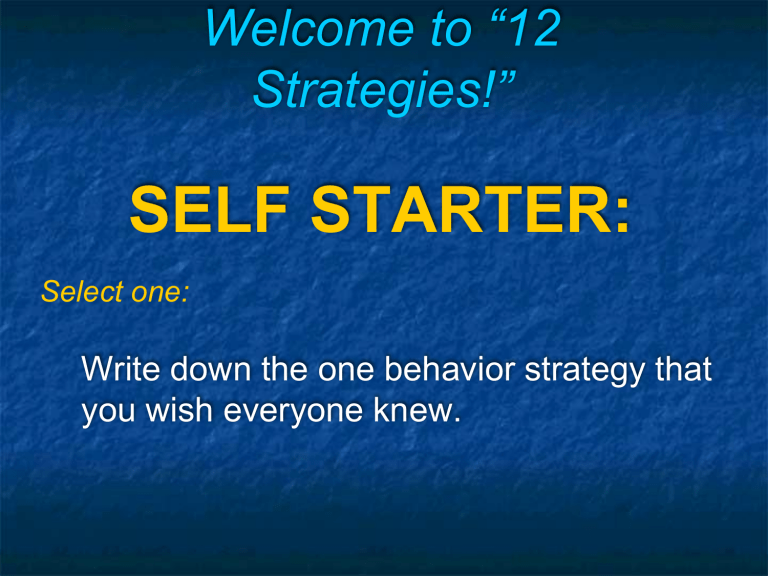
Welcome to “12
Strategies!”
SELF STARTER:
Select one:
Write down the one behavior strategy that you wish everyone knew.
Public Education:
We Teach Them ALL
Students who have…
Disabilities
Extraordinary Gifts
Ethnic Differences
Home Language Other Than English
Economically Disadvantages
Medical Issues
Public Education:
We Teach Them ALL
Students who are…
Highly distractible and highly verbal
Conflicted with issues at home
Mobile, attending a number of schools
Focused on peers and social relationships
Non-readers
Tired from part time jobs, late parties
“I think I’ll take the day off!”
“Looks like we lost another
good teacher!”
“Looks like we lost another good teacher!”
What it takes to control your class:
“Good classroom managers are teachers who understand and use specific techniques.”
--Robert Marzano, 2003
What it takes to control your class:
“Good classroom managers are teachers who understand and use specific techniques.”
ENGAGEMENT:
23 percentile points higher
--Robert Marzano, 2003
What it takes to control your class:
“Good classroom managers are teachers who understand and use specific techniques.”
ENGAGEMENT:
23 percentile points higher
ACHIEVEMENT:
20 percentile points higher
--Robert Marzano, 2003
“Sure teaching is both an art and a science…bu t it’s also guerrilla warfare.”
So, what’s with these
12 strategies?
Focused on new teachers
Not new, just compiled
Not every teacher needs every strategy
Helpful for mentors, principals
Acknowledgements…
5 Assumptions
1.
Prevention is more effective than intervention.
5 Assumptions
1.
Prevention is better than intervention.
2.
Good relationships are your most effective tool.
5 Assumptions
1.
2.
Prevention is better than intervention.
Good relationships are your best tool.
3.
There is no substitute for good instruction.
5 Assumptions
1.
2.
3.
4.
Prevention is better than intervention.
Good relationships are your best tool.
No substitute for good teaching.
Effective strategies are those that preserve dignity.
5 Assumptions
1.
2.
3.
4.
Prevention is better than intervention.
Relationships are your best tool.
No substitute for good teaching.
Effective strategies preserve dignity.
5.
Acting the professional works.
“I’m home a little early, dear.
The kids torched the school.”
6 Strategies to
Prevent
Behavior Problems
STRATEGY 1: Social Cues
STRATEGY 1: Social Cues
A simple statement that a teacher makes to a class that…
…restates a desired behavior,
…attributes it to a specific student,
…loud enough to ‘cue’ the entire class,
…targeted to an area of teacher concern,
…indicates that this behavior helps you.
STRATEGY 1: Social Cues
“What should their behavior look like or sound like?”
--Dr. Ellen Williams (1996)
STRATEGY 1: Social Cues
CAVEATS:
…Don’t over use them, 2 or 3 should be enough.
…Adjust to the age of your students.
…Never use sarcasm!
…Be sincere.
STRATEGY 1: Social Cues
THINK TIME:
What is the difference between a social cue and a positive comment?
STRATEGY 2: Attention Signal
STRATEGY 2: Attention Signal
A signal saying you are ready to begin, so their attention is required.
STRATEGY 2: Attention Signal
1.
2.
3.
4.
5.
6.
Give a warning.
Take your mark.
Use your signal.
Make eye contact.
Use 2 or 3 social cues.
Begin immediately.
STRATEGY 3:
Use Self Starters
STRATEGY 3:
Use Self Starters
Behavior in my classroom is NOT an extension of behavior in the halls.
I need 5-10 minutes to take roll, sign notes, and open my lesson plan.
I need your full attention when I am ready to begin today’s lesson.
Take time to get yourself organized and settled down to begin today’s work.
STRATEGY 3:
Use Self Starters
1.
Directions & materials
STRATEGY 3:
Use Self Starters
1.
Directions & materials
2.
5 to 10 minutes
STRATEGY 3:
Use Self Starters
1.
2.
3.
Directions & materials
5 to 10 minutes
Most students already fluent
STRATEGY 3:
Use Self Starters
1.
Directions & materials
2.
5 to 10 minutes
3.
Most students already fluent
4.
Work must be turned in
STRATEGY 3:
Use Self Starters
EXAMPLES:
One paragraph: should colleges spend millions of education dollars on football?
Calculate the average of…
Pick a tool that can slice off a finger, then write 5 safety rules for its use.
Should a mosque be built next to 9/11’s
“ground zero” in New York? Why?
List as many adjectives as you can.
STRATEGY 4:
Proximity Control
STRATEGY 4:
Proximity Control
Reflection Question:
In your classroom who is giving you the best attention… the kids in the front rows, or the kids in the back?
STRATEGY 4:
Proximity Control
Move frequently throughout your classroom to constantly create new
“front rows” of student attention.
STRATEGY 4:
Proximity Control
Stay on the move during…
Seatwork
Lectures
Demonstrations
Group work
Overhead presentations
Don’t sit at your desk when students are present.
STRATEGY 5:
Use Time Limits
STRATEGY 5:
Use Time Limits
Reflection Question:
Do your students think they have plenty of time to just kick back?
STRATEGY 5:
Use Time Limits
Time as a Teacher’s Ally:
Improves our efficiency
Motivate students
Keep activities fresh, our pacing crisp
Help them learn to manage their time
Anchor students in the moment
Communicates that you are organized
STRATEGY 5:
Making Time YOUR Ally
1.
2.
Sub-divide block periods
Post today’s schedule
3.
Give a clear time limit for each task
4.
Give 1-2 minute warnings
5.
6.
Use a timer or a watch
Make use of “wait time”
STRATEGY 6:
Manage Your Transitions
STRATEGY 6:
Manage Your Transitions
What bugs you about your transitions?
STRATEGY 6:
Manage Your Transitions
STRATEGY 6:
Manage Your Transitions
5.
6.
7.
1.
2.
3.
4.
Be prepared!
Use your attention signal.
Explain your expectations.
Opportunity to ask questions.
Signal to begin, use social cues.
5-second warning
Use your attention signal.
STRATEGY 6:
More Transition Tips
2.
3.
4.
1.
5.
“Ticket”: write down 1st & 2nd things you will do when you enter the shop.
“Sell” the next activity.
Prepare an attention grabber.
Try to simplify by numbering the next steps students are to take.
Give a warning that a transition is about to occur
3 Strategies to Develop
Positive Relationships
STRATEGY 7:
Show You Care
STRATEGY 7:
Show You Care
1.
2.
3.
4.
5.
Smile often
Use names
Share a laugh
Notice your students
Greet your students at the door
STRATEGY 7:
Show You Care
1.
2.
3.
4.
5.
Smile often
Use names
Share a laugh
Notice your students
Greet your students at the door
CAUTION: Be the teacher, not the peer.
STRATEGY 8:
Build Trust
STRATEGY 8:
Build Trust
1.
If you say it, mean it.
STRATEGY 8:
Build Trust
1.
If you say it, mean it.
2.
Be consistent.
STRATEGY 8:
Build Trust
1.
2.
If you say it, mean it.
Be consistent.
3.
Be the professional.
STRATEGY 9:
Show Respect
STRATEGY 9:
Show Respect
The only thing we can really control…
… is ourselves!
5.
6.
7.
8.
1.
2.
3.
4.
STRATEGY 9:
Show Respect
Address students by name
Use ‘Please’ and ‘Thank you’
Use a calm, warm speaking voice
Smile
Avoid sarcasm
Be on time and be ready
Assume benevolence
Preserve student dignity
STRATEGY 9:
Show Respect
“We must be the change we wish to see in the world.”
--Mahatma Ghandhi
Strategies to Intervene when
Behavior Problems Arise
Strategies to Intervene when
Behavior Problems Arise
Teachers who use effective interventions decrease classroom disruptions by
32 percentile points!
--Robert Marzano, 2003
STRATEGY 10:
The Clipboard Technique
STRATEGY 10:
The Clipboard Technique
Do your students believe they will be held accountable for their behavior?
STRATEGY 10:
The Clipboard Technique
Carry the class roster with you on a clipboard.
Show you notice.
Use the data.
Notice the positive, use incentives.
STRATEGY 10:
The Clipboard Technique
Check the Chart before:
“I need someone to go to the computer to look up…”
“OK, as I call your name you can move into the shop to get started.”
[Intercom:]
“Please send someone to pick up…”
STRATEGY 10:
The Clipboard Technique
Check the Chart before:
“The following students can now go to the library…”
“Mark, instead of this one, could you help Juan with his assignment?”
“I need someone to help me set up…”
STRATEGY 10:
The Clipboard Technique
Adaptation: during the self starter…
walk about the room (proximity) take roll roll on the clipboard, mark late-comers as they enter, mark homework completion deal with individual issues.
Strategies to Improve the
Quality of our Instruction
Could there be a relationship between the
quality of classroom instruction, and
the quality of student behavior?
Strategies to Improve the
Quality of our Instruction
As a student, think of a time when
YOU caused problems for your teacher. Write down what caused you to do this.
STRATEGY 11:
Keep Your Pacing Crisp and
Your Students Active
STRATEGY 11:
Keep Your Pacing Crisp
Attention span is about half the student’s age.
(Fortin 2008)
STRATEGY 11:
Keep Your Pacing Crisp
Attention span is about half the student’s age.
(Fortin 2008)
35 years ago average a 13-yearold’s attention span was 15 min. Today average adult attention span is only
20 min.
(Reynolds 2008)
STRATEGY 11:
Keep Your Pacing Crisp
Attention span is about half the student’s age.
(Fortin 2008)
35 years ago average 13-year-old attention span was 15 min. Today average adult attention span is only 20 min.
(Reynolds 2008)
In England the attention span of adults has fallen from 12 min. to 5 min over the past 10 years. (Lloyd’s 2008)
STRATEGY 11:
Keep Your Pacing Crisp
Why has the attention span of our students become so short?
STRATEGY 11:
Keep Your Pacing Crisp
Pick up the pace.
Move beyond the rote.
Break up the boredom with changeups.
Use ‘Sponge Activities.’
Strategies to Improve the
Professionalism of our
Practice
“That’s the second time this week that
Ms. Dickey has left her class early to go home sick.”
Strategies to Improve the
Professionalism of our
Practice
Write down the one behavior strategy that you wish everyone knew.
STRATEGY 12:
Keep Up
STRATEGY 12:
Keep Up
“Withitness”
Jacob Kounin (1970)
STRATEGY 12:
Keep Up
What can teachers do to have
‘eyes in the back of your head?’
STRATEGY 12:
Keep Up
Scan the class frequently.
Buffer the interruptions.
Avoid procedures that encourage distractions.
Intervene in a timely, accurate fashion.
